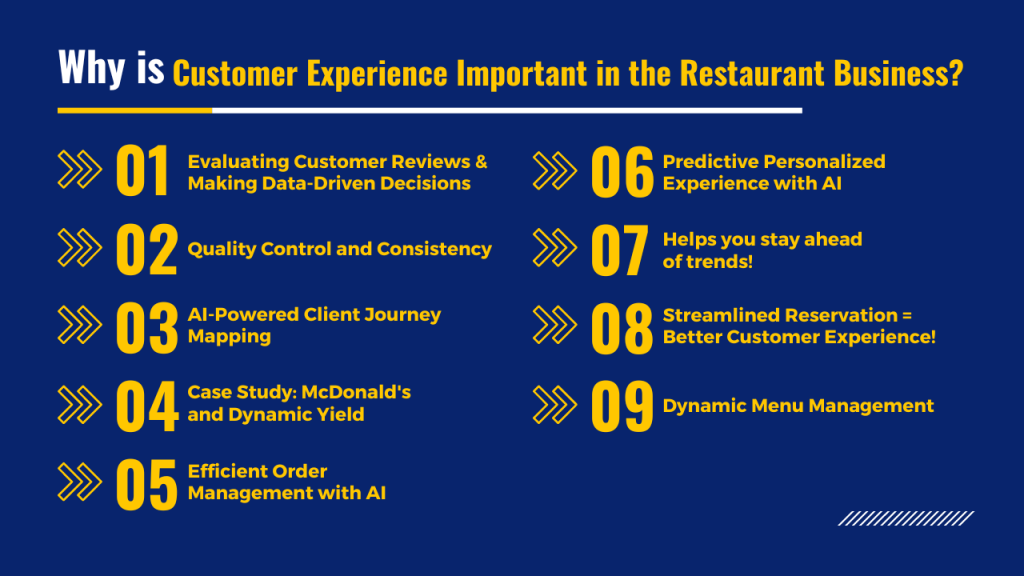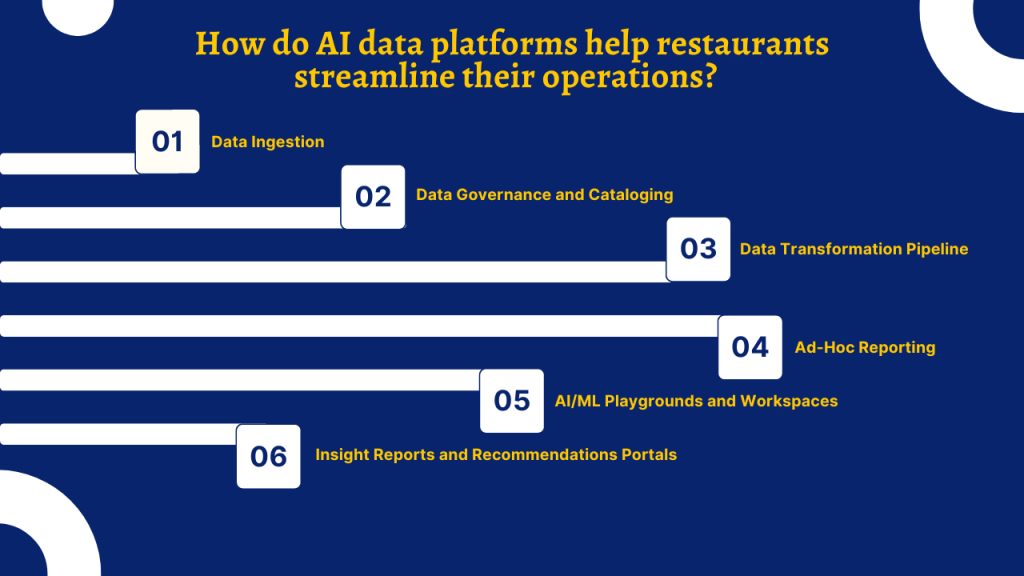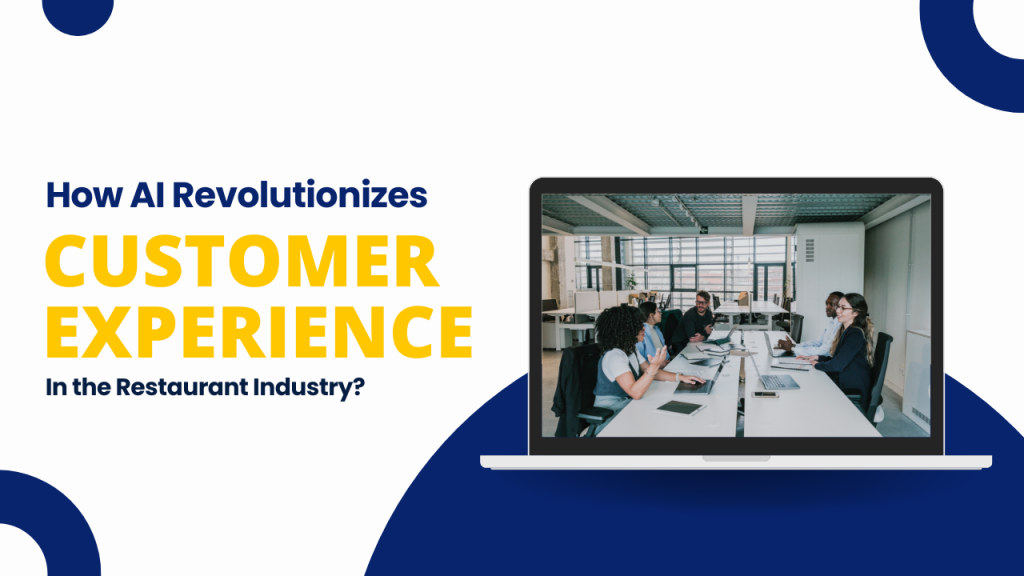Introduction
AI technology is rapidly advancing and making its mark across various industries, and the restaurant industry is no exception. In an environment that is both highly competitive and rapidly evolving, staying ahead requires leveraging every available advantage.
Thank you for reading this post, don't forget to subscribe!One of the most powerful resources at a restaurant’s disposal is data. When utilized effectively, data can be a goldmine, unlocking new opportunities and driving significant improvements in both operations and customer satisfaction.
Gartner Research indicates that by 2025, AI will be a standard technology used by 75% of the food service industry to enhance customer service and streamline operations.
For restaurant owners, data includes a wide range of information, from sales history and customer preferences to seasonal trends and market conditions.
In this blog, we will explore how AI enhances customer experiences in the restaurant industry. Keep reading to discover the transformative power of AI and how it can bring out the best in your restaurant business.
Also Read: AI to Collect Customer Insights
Why is Customer Experience Important in the Restaurant Business?
“People will forget what you said, people will forget what you did, but people will never forget how you made them feel.” – Maya Angelou.
This quote is especially relevant in the restaurant business. For restaurants, focusing on customer experience has become essential for gaining a competitive edge and ensuring long-term success.
Think about it—when you visit a restaurant, it’s not just about the food. It’s about the ambiance, the service, and the overall vibe. If a restaurant can get that experience right, you’re more likely to come back and even recommend it to others. That’s where AI comes in.
AI helps restaurants understand their customers better by analyzing data and predicting their needs. In today’s competitive market, having great food isn’t enough. Restaurants need to offer an exceptional overall experience to stand out.
So, if you’re in the restaurant business, it’s time to embrace AI and make customer experience your top priority. It’s the key to unlocking success and staying ahead in the marketplace.

Let’s keep reading to know how AI helps restaurants in boosting customer experience:
Evaluating Customer Reviews & Making Data-Driven Decisions
We all know that individuals are frequently brutally honest in online evaluations, but you can use this information to your restaurant business advantage and benefit from it.
AI for your restaurant business delivers semantic analysis, allowing you to delve deeper into the meaning behind your clients’ words and make better decisions that work in your restaurant business’s favor. You can tell how people feel about your restaurant.
Another reason to pay attention to online reviews, collect the data and implement the needful in your restaurant. They have a significant statistical influence on subsequent visitors.
Consumers read restaurant reviews more than any other industry, with 90% of us choosing a restaurant based on online ratings. With AI, you can analyze your restaurant reviews and customer satisfaction questionnaires to display statistics and exploit data for your business.
Quality Control and Consistency
In the restaurant business, consistency is key to customer satisfaction and ensures customer retention and referrals as well. If the customer is coming back to your restaurant for their favorite meal or cup of coffee – then you have to be consistent with the quality and quantity.
If you lose out on your consistency, you will ultimately lose the customers and your trust in the brand. Well, AI plays a big role in this as well. It makes sure that restaurants maintain consistency throughout their operations.
Let’s find out how.
The best AI data tool can help you monitor and analyze information on food quality, service, and customer feedback. And, restaurants can leverage the data collected to keep food quality standards consistent.
Therefore, in addition to having a large number of positive evaluations and a high rating, your restaurant should also be able to reply to feedback quickly. Prospective visitors want to know that you value their experience.
It works across multiple dishes, lowers service faults, and responds rapidly to challenges. Customers always get to enjoy consistently great dining experiences because of this proactive approach to quality management. It promotes customer happiness and loyalty.
AI-Powered Client Journey Mapping
The AI tool and AI-driven customer journey mapping combine data from several touchpoints to create a comprehensive view of the customer experience in the restaurant business.
Businesses can create more cohesive and customized engagement by using it to gain a deeper understanding of consumer interactions and preferences. Companies may significantly boost customer satisfaction and loyalty by optimizing the entire customer experience.
AI tools analyze customer data to understand preferences and behaviors, enabling personalized suggestions. For instance, 80% of consumers are more likely to make a purchase when brands offer personalized experiences.
AI-driven systems can recommend dishes or promotions based on previous orders and help design and manage loyalty programs that offer tailored rewards, increasing customer retention.
Case Study: McDonald’s and Dynamic Yield
McDonald’s acquired Dynamic Yield and by integrating Dynamic Yield’s AI technology, McDonald’s aimed to personalize the drive-thru experience by suggesting items based on time of day, weather, current restaurant traffic, and trending menu items.
This AI-driven recommendation system not only improved the customer experience but also increased sales. For example, during the pilot phase, McDonald’s saw a noticeable increase in average check size due to the AI’s ability to upsell and cross-sell items effectively.
This implementation of AI has been part of McDonald’s broader strategy to modernize its operations and improve customer satisfaction.
Efficient Order Management with AI
AI-powered systems help restaurants manage orders more efficiently, reducing wait times and improving accuracy. These systems use machine learning to handle high volumes of orders quickly, ensuring customers receive their meals promptly.
During busy hours, AI can prioritize orders based on factors like preparation time and kitchen capacity, ensuring timely fulfillment and minimizing errors.
AI also integrates with point-of-sale (POS) systems to provide real-time updates to customers about their order status, enhancing transparency and reducing anxiety related to waiting times. By automating routine tasks, AI allows staff to focus more on customer interaction and personalized service, improving the overall dining experience.
The quick tip: Make sure to integrate your AI platform with the POS system and other platforms to ensure compatibility and real-time data updates.
Case Study: Domino’s Pizza Used AI for their business operations!
Domino’s Pizza is a great example of how AI improves order management. The AI-powered system, “Domino’s AnyWare,” allows customers to place orders through various platforms like voice assistants and social media.
The AI system integrates with Domino’s operations to manage orders efficiently. By predicting order volume based on historical data and current trends, Domino’s can prepare for busy periods, reducing wait times and improving order accuracy.
This has led to higher customer satisfaction, demonstrating AI’s potential to enhance order management and overall customer service in the restaurant industry.
Predictive Personalized Experience with AI
AI makes it easier for restaurants to analyze user interaction history and predict customers’ next moves. By leveraging these insights, restaurants can have highly personalized services. This approach not only enhances customer engagement but also boosts profitability.
According to a report by McKinsey, successful personalization can lead to 20% higher customer satisfaction, 20-30% increased employee engagement, and 10-15% higher sales conversion rates.
For instance, AI can track a customer’s past orders, favorite dishes, and dining times. If a customer frequently orders a specific meal on Friday evenings, the AI system can predict this pattern and send a personalized offer or reminder on Friday afternoon, encouraging the customer to place their order. Similarly, AI can suggest new menu items based on a customer’s previous choices, increasing the chances of upselling and cross-selling.
Moreover, it can enhance the entire dining experience by remembering seating preferences, dietary restrictions, and even special occasions, making customers feel valued and understood. This level of personalized service fosters stronger customer loyalty and repeat business.
Helps you stay ahead of trends!
AI empowers restaurants to gather and analyze vast amounts of customer data, competitor insights, and industry trends to effectively predict the future of their business.
By leveraging AI-driven analytics, restaurants can track customer preferences, dining habits, and feedback across various touchpoints. This data helps in understanding what drives customer satisfaction and loyalty, enabling restaurants to tailor their offerings and services accordingly.
Moreover, AI enables restaurants
- to monitor competitor strategies
- market trends in real time,
- identifying emerging opportunities and potential threats
By predicting future trends based on historical data and current market dynamics, AI equips restaurant owners and managers with valuable foresight to make informed decisions, optimize operations, and stay ahead in a competitive market.
This proactive approach not only enhances business agility but also fosters continuous improvement in customer experience and overall business performance.
Streamlined Reservation = Better Customer Experience!
Managing reservations is kind of difficult and tiresome. But, in these dynamic digital times – you can leverage AI to streamline the reservation process for your restaurants.
With AI-powered systems, customers can make reservations through websites, mobile apps, and voice assistants without needing to wait for a human response. These systems update reservation availability in real time, preventing double bookings and ensuring accurate details.
AI also optimizes table allocation by considering factors like party size, dining duration, and table turnover rates, which maximizes seating efficiency.
The AI reservation system, also ensures instant confirmations and reminders, while reducing no-shows and ensuring timely arrivals.
AI also helps in effectively managing waitlists by predicting table availability and wait times, keeping customers informed, and reducing frustration. By analyzing reservation patterns, AI helps restaurants forecast demand and plan staffing accordingly.
Let’s understand with an example!
Imagine your restaurant is getting ready for a busy Friday night. With an AI-powered reservation system, managing reservations becomes much easier. Customers can book a table through your website or app, and the system updates available time slots instantly, preventing double bookings and ensuring accuracy.
When a customer makes a reservation, the AI confirms it right away and sends a reminder on the day of their visit. If you’re fully booked, the AI can put the customer on a waitlist and predict the wait time, keeping them informed.
For your staff, the AI analyzes past reservations and predicts a busy night, helping you prepare by suggesting the best table arrangements and ensuring enough staff are scheduled. This means your team is ready to provide excellent service, regardless of the situation.
Dynamic Menu Management
Dynamic menu management is important in the restaurant business – because customers want to try something new and that has been trending. But, it is not that easy to introduce the right items that your customers will love.
That’s when AI comes to the rescue.
AI plays a crucial role in dynamic menu management by analyzing data from various sources like sales history, customer preferences, seasonal trends, and market conditions. It identifies patterns and insights that help in making informed menu adjustments.
For example, AI can determine the most popular dishes, which ingredients are often left unused, and which items receive the highest customer ratings. This helps restaurant owners make data-driven decisions about what to feature on their menus.
On top of it, AI can also help restaurants identify what’s happening in the market, what competitors are doing, and what your customers want to determine the best.
By continuously analyzing and updating the menu in real-time, AI ensures that the menu remains relevant, appealing, and optimized – which ensures higher customer satisfaction, profitability, retention, and improved brand reputation as a whole.
Also Read: How to Use AI in Restaurant Business
How do AI data platforms help restaurants streamline their operations?

To leverage the data for the restaurants and to ensure the best-in-class customer experience, businesses need to collect, analyze, prepare, integrate, and transform the data. All this is quite tiresome, lengthy, and error-prone. But, with AI – you can be able to make the most out of the data in your business favor.
Let’s find out how.
Data Ingestion:
- Collection: AI systems gather data from various sources such as point-of-sale (POS) systems, online orders, customer feedback, social media interactions, and reservation platforms. This wide array of data provides a holistic view of customer behavior and operational metrics.
- Integration: Once collected, the data is integrated into a centralized platform. This ensures that all information is aggregated in one place, making it easier to analyze and draw comprehensive insights.
Data Governance and Cataloging:
- Organization: Data governance involves structuring and cataloging data to maintain its quality, consistency, and security to make sure the data is reliable.
- Access Control: Policies are established to control who can access different types of data, ensuring data privacy and compliance with regulations such as GDPR. This step is crucial for protecting sensitive customer information and maintaining trust.
Data Transformation Pipeline:
- Processing: The AI tool also helps businesses in processing the raw data and transforming it into a structured format suitable for analysis. This includes cleaning the data to remove errors, duplicates, and inconsistencies that could skew results.
- Enrichment: With AI, enriches businesses with additional information such as customer demographics, purchasing history, and external market data. This enrichment provides deeper insights and a more nuanced understanding of customer behavior and market trends.
Ad-Hoc Reporting:
- Generate Reports on the go: AI tools can seamlessly generate reports on demand without any human assistance. Managers can generate insights tailored to specific needs or questions, such as sales trends, inventory levels, or customer satisfaction metrics.
AI/ML Playgrounds and Workspaces:
- Experimentation: The AI tools are enriched with machine learning algorithms. With all the data in place, the AI tool can suggest recommendations and suggestive references which can help restaurant businesses make the right decisions which is beneficial for businesses.
- Development: Teams can develop and refine predictive models to understand trends, customer behaviors, and operational efficiencies. These models can forecast demand, optimize inventory, and improve staffing schedules.
Insight Reports and Recommendations Portals:
- Analysis: AI analyzes the transformed and enriched data to generate comprehensive insight reports. These reports provide a detailed look at various aspects of the business, from sales performance to customer preferences.
- Recommendations: The reports include actionable recommendations such as menu optimization, pricing strategies, marketing campaigns, and staffing adjustments. These recommendations are based on data-driven insights, helping managers make informed decisions.
- Accessibility: Insights and recommendations are accessible through dedicated portals, providing managers with easy-to-understand, data-driven guidance. This accessibility ensures that critical insights are available to decision-makers when needed.
To Conclude
In this blog, we’ve explored how AI is transforming restaurant operations and boosting customer satisfaction. From streamlining order management and personalizing experiences to optimizing inventory and providing valuable insights, AI helps restaurants run more efficiently and keep customers happy.
We’ve highlighted the benefits of using AI, followed by how AI tools work, from collecting data to generating helpful reports and recommendations.
If you’re interested in streamlining operations and leveraging data to your rescue for your restaurant with AI, then Livelytics has got you covered. It’s a unique AI data platform designed specifically for restaurants, offering tools and capabilities to help you make the most of your data.
To know more about the platform and whether it fits within your restaurant business you can book a free demo now.
